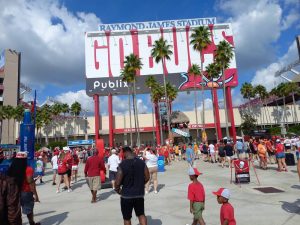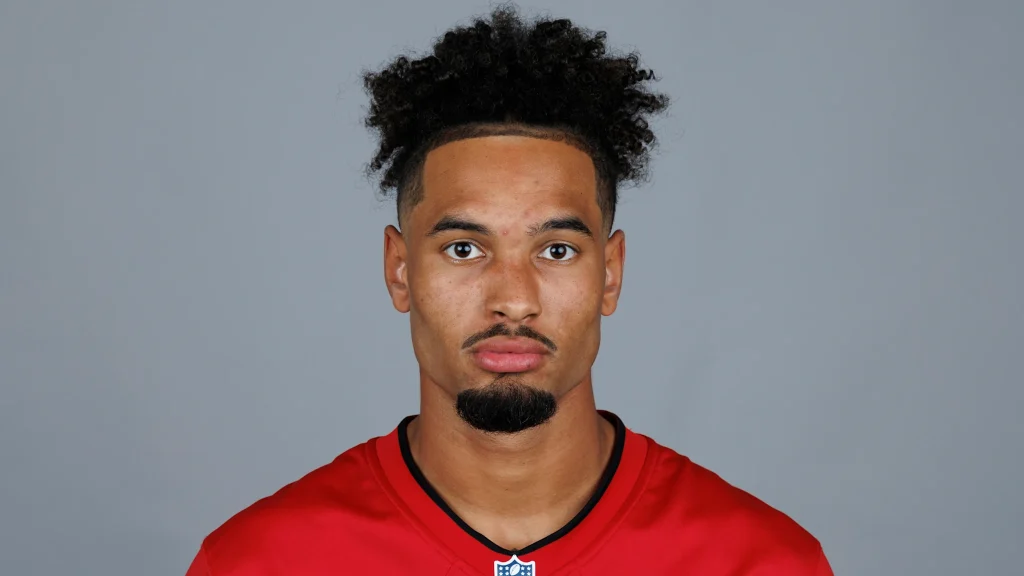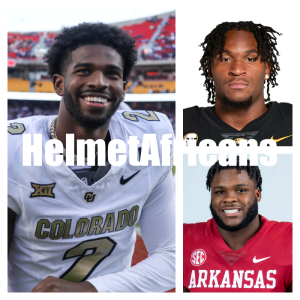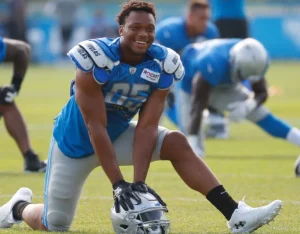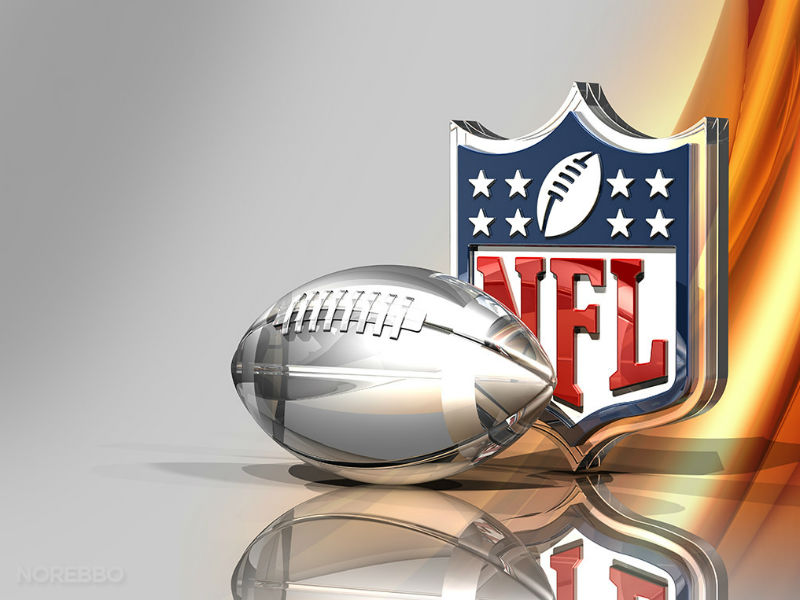
An NFL game may appear complex. There is often massive chaos of less than 10 seconds followed by peace of 25 to 40 seconds. But the aim is simple. Like soccer , the goal (haha) is to score a goal, which is to move the ball past the opponent’s goal lin. The area behind the goal is called the END ZONE. The difference between football and soccer is that a football team counts success, not only when it scores a goal, but also when it is able to move the ball 10 yards or more in four attempts or less in the direction of the opponent’s END ZONE. Each 10 yards brings the team nearer the goal
THE KICK OFF
A game starts when one team kicks the ball to another team. The team that just got the ball goes into OFFENSE to DRIVE (move) the ball from its end to the END ZONE of the opponent. At any one time, only one team can be in offense; the other team DEFENDS to prevent the offense from scoring. This beginning kick is called the KICK OFF
THE DRIVE
The OFFENSE has four chances or DOWNS to move the ball a minimum of 10 yards from where they got it. It can move it more than 10 yards, even the entire length of the field to score, in one play, if it is able to. But the minimum distance is a total of 10 yards in 4 plays. The OFFENSE gets another four sets of DOWNS to try advances 10 yards or more in four downs or less. This continues until it scores. If the OFFENSE cannot move the 10 yards in 4 sets of downs, its drive has STALLED, and it must give the ball to the opposing side which now will start its own DRIVE to score
The first attempt by an OFFENSE to move the ball is called the FIRST DOWN; the second attempt the SECOND DOWN; and so forth until the fourth which is called the FOURTH DOWN. They measure progress of an OFFENSE via a DOWN & DISTANCE CALL. For example, a call of 2nd and 5 means the next play or down will be the 2nd down with 5 yards to go. Similarly, 4th and 10 means 4th Down with 10 yards to go. Hence the first attempt after a KICK OFF is called a 1st and 10. First down with 10 yards to go
A team kicks the ball the same way to the opponent to begin a game or after it has scored a goal.
Between downs, team members communicate among themselves on what the next PLAY would be. A play to advance the ball could be a pass or run play or a combination of both where a player catches a PASS and then runs with it unless he is TACKLED and brought down. Often, the play comes from a coach on the sidelines.
Each play begins when the CENTER (usually a fat but agile player) SNAPS the ball back to the Quarterback (QB). The QB is the most important position in football and acts like the field marshall of the offense. He would throw the ball to a team mate as a PASS; hand it over to a runner; or try to run it forward himself.
A team gets six points when it scores by a run or pass or a pass followed by a run. After each TD, the scoring team can earn one extra point by successfully kicking a goal from the two yard line. This is effectively a 20 yard kick because the goal post is 18 yards beyond the goal line. A more daring extra points play is when the team elects to forego the kick but successfully scores again by running a regular play from the two yard line
Where the team has not advanced the ball the required 10 yards in 3 downs, it can try to advance on a fourth try or down. It can also kick a goal if the ball is close enough to the goal, closer than the opponent’s 35 yard line. A ball on the 35 yard line is considered a 53 yard field goal kick because the goal post is 18 yards beyond the end (zero) line at the end of the playing field. Beyond the 40 yard line, most teams will PUNT to ensure that the opponent starts their own drive far from the kicking team’s goal. Trying to advance the ball (GOING FOR IT) on the 4th is considered a gamble because the opponent gets the ball wherever the ball ends if the DRIVE stalls (does not achieve the cumulative 10 yards or more in 4 attempts).
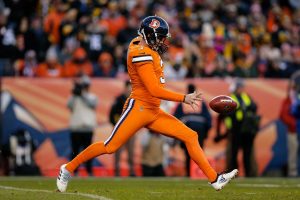
After a stalled drive, the team that played defense gets the ball via a chaotic, exciting, and dangerous play called a PUNT. In a punt, the team kicks the ball high up into the air as far as possible toward the goal line of the opponent, but without it getting past that goal line. The RECEIVING TEAM catches the ball and tries to run it back toward the goal of the KICKING TEAM. Players of both teams collide with each other at very high speeds as the kicking team tries to stop the receiving team from advancing the ball too far forward.
It is at this point that the receiving team now becomes the OFFENSE and starts its own drive to score.
Sometimes a kick off or a punt turns into a TOUCHBACK when the ball enters the ENDZONE after a kick or punt. A TOUCHBACK results in a penalty for the kicking or punting team. In a PUNT, the receiving team advances the ball to its own 20 yards; it thus has to drive only 80 yards to score. After a kick off, the team starts on the 25 yard line. But a TOUCHBACK is considered a good thing in a kick off.
SPECIAL TEAMS
Each NFL team has 53 players. Eleven players are on the field for each phase of a game – offense, defense, or special teams. Each team can substitute players at will. While some players may start and play most of the game, some are called in for just a few plays. Some are specialists on specific downs – like 3rd down. Rarely does a person who plays offense also play defense
SPECIAL TEAMS is the name given to the team when it is playing in a punt or kick off. The KICKER and PUNTER are the most well known players on special teams. The person who holds the ball for the kicker is called a HOLDER. A SNAPPER (also called LONG SNAPPER) snaps the ball backwards for the PUNTER to kick
TURNING THE BALL OVER
In certain situation, the ball ends up in the opponents hands when the OFFENSE or SPECIAL TEAMS makes a mistake or encounters some bad luck.
In one, a player on DEFENSE INTERCEPTS (ENDS UP WITH) the ball that the QB was throwing to another player on his OFFENSE. An interception is also called a PICK. An interception where the player runs it all the way to score is called a PICK SIX.
Sometimes, a player on OFFENSE FUMBLES (drops) the ball and an opponent on DEFENSE scoops it up, occasionally to run it all the way to the goal. A fumble can also occur when a player on DEFENSE rips the ball out of the hands of an offensive player.
SPECIAL TEAMS play also cause lots of excitement or misery (depending on what side you are on) due to turn overs. Sometimes, a person who catches a PUNT or a KICK drops the ball and opponent recovers it
THE SAFETY
When a player is tackled (and stopped) in his own END ZONE, the opposing team scores a SAFETY and is awarded two points. The team that just gave up the two points also must kick the ball to the opponent for the latter to start a drive. For the team that lost the ball, a SAFETY is a lesser evil because the other team would have been six points (TD) if it had recovered the ball in that END ZONE
SCORING
Touchdown six points
Field goal three points
Point after Kick 1 point
Run/Pass 2 points
Safety 2 points
PENALTIES
American football is complex due to the large amount of rules. Violation of these rules is called a penalty, equivalent to FOUL, in soccer. There are a few common ones in a normal game
- FALSE START is when a person on the offense moves before the ball is snapped back to the QB. The penalty is for the offense to move back 5 yards
- ENCROACHMENT When the defense crosses over a neutral zone to the side of the offense before the ball is snapped. The offense gets to advance 5 yards as a freebie
- HOLDING A player holds another player on the opposing side. The penalty is 10 yards when the foul is done by a person on the OFFENSE. It is five or 10 yards if the fault is from a DEFENSIVE player
- UNNECESSARY ROUGHNESS Usually due to an inappropriate tackle or hit on an opposing player. If the person hit is the QB, then the penalty is called ROUGHING THE PASSER
- PASS INTERFERENCE When a player holds or pushes another player to prevent him from catching a pass. Usually the transgressors are on the defense, in which case, the ball is placed where the foul was committed. The ball is moved back 10 yards if an offensive player was the guilty party

